Six Unpublished Nabataean Drachms: Filling some Gaps
Abstract:
Six hitherto unknown dated Nabataean drachms from the reigns
of Aretas IV, Malichus II, and Rabbel II are described in this
article. The existence of these coins tightens some of the
temporal gaps in the dated silver coinage of this period.
Insight into the scarcity of silver within the Nabataean kingdom
during this period is demonstrated. Suggestions as to yet
undiscovered dated drachms are also made.
Key Words:
Numismatics, Nabataean coinage,
Aretas IV,
Malichus
II,
Rabbel II
Zusammenfassung:
Sechs bisher unbekannte nabatäische Drachmen aus der
Regierungszeit von Aretas IV., Malichus II. und Rabbel II.
werden in diesem Artikel vorgestellt. Die jeweils datierten
Münzen schließen einige der zeitlichen Lücken in der
Silberprägung dieser Zeit. Einblick in die Silberknappheit im
nabatäischen Königreichs während dieser Periode wird gegeben.
Für bislang (noch) nicht nachgewiesene datierte Drachmen lassen
sich Vermutungen aufstellen.
Schlagwörter:
Numismatik, nabatäische Münzprägung, Aretas IV., Malichus II.,
Rabbel II
Late Nabataean silver
drachms were produced during the reigns of Aretas IV, his son
Malichus II, and his son, Rabbel II. Upon the Roman conquest of
106 CE, Nabataean coinage came to an end. For most of this
period, ranging from 9 BCE to 106 CE, small silver drachms were
produced, becoming the standard commercial coinage of the
kingdom. The weight of these drachms ranges from almost 3 to 4.5
grams with a decreasing silver content of approximately 80 to
50%. Several comprehensive studies dedicated to Nabataean coins
have been published over the past two years, greatly enhancing
the basis set by Ya'akov Meshorer in his Ph.D. thesis published
in 1975[1].
Meshorer, recently updated by Rachel Barkay[2]
and Younis Al-Qatanani[3],
described the known set of dated silver drachms during the reign
of these three kings. The majority of the Nabataean silver coins
is dated, providing a unique insight into the complex and
dynamic history of this desert kingdom. During this period of
nearly a century, drachms were produced almost every year.
However, certain years silver coins were not minted or at least
not (yet) discovered based on our current understanding of the
existing known coinage. The intention of this article is to fill
some of these temporal gaps with hitherto unknown dated coins,
proving the production of silver drachms for six more years,
all during the first century common era (CE), 13/14, 31/32,
53/54, 83/84, 84/85, 87/88. We also confirm existence of a
drachm dated 32/33 and 100/101.
Coins
1. Aretas IV, Year
22, 13/14 CE, AR Drachm, 16 mm, 4.22 g, 1 h (fig. 1)
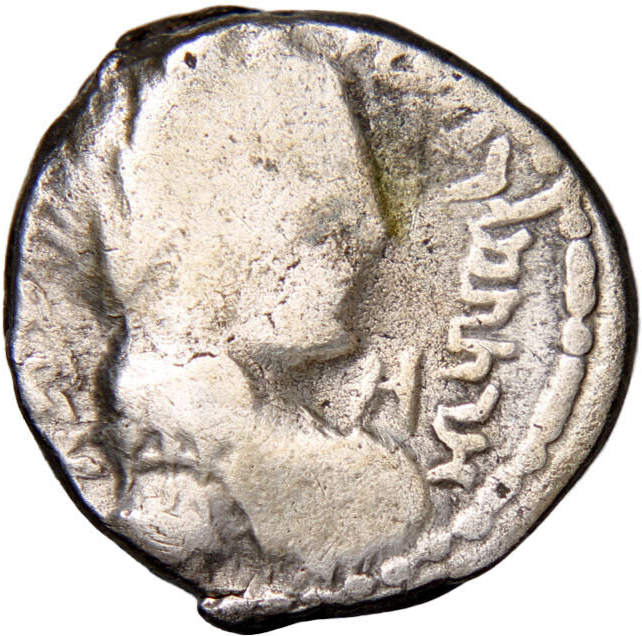
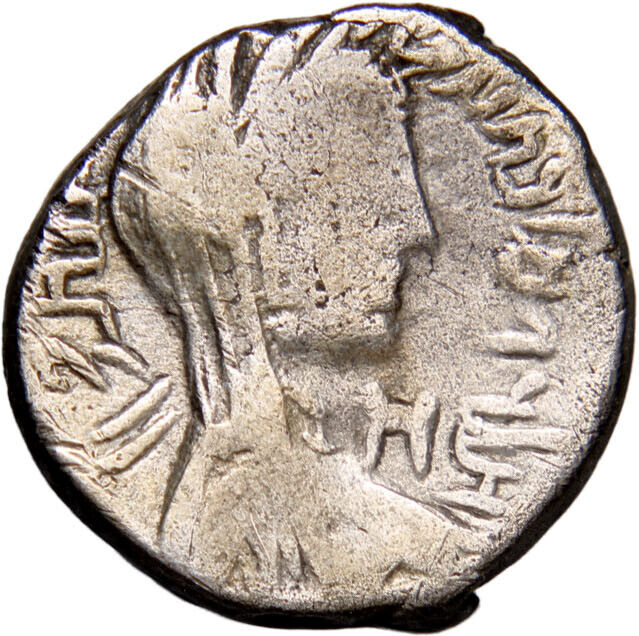
Obv.: Bust of Aretas IV
r. laureate, with curls flowing down from the side of his
forehead and reaching his shoulders, the lower part of each lock
twisted into a vertical coil. He wears a mantle with a V-shaped
collar and decoration on the shoulders; around from r. below: »Aretas king of the
Nabataeans who loves his people«, in the field, r.:
ח
Rev: Bust of Huldu r.,
laureate, draped and veiled, with a curl on the cheek; around
from r. below:); in field r.:
ח
Until recently no silver
coins dated to the reginal years 18 to 25 of the Aretas IV
period were known[4].
During the years 22 and 24 silvered (or plated) coins with a
bronze core mimicking regular silver coinage were minted[5].
These silvered coins suggest that no standard silver coins were
minted during this period, probably due to a shortage of silver[6]
since the silvered coins would have driven silver coins out of
circulation (Gresham’s law). A silver drachm dated year 21 from
the Uri Aka-Mizrahi collection was however recently published[7].
The coin pictured in fig. 1 is similar in style to the
Aka-Mizrahi coin; in fact, the present coin is so similar to the
coin of Aka-Mizrahi that it is tempting to assume that the dies
were produced by the same engraver. Interestingly, both of these
coins are quite different from the bronze core coins dated year
22.
We do not currently know
whether the silver and silvered coins were simultaneously
produced or whether minting of the silver drachms stopped
sometime during year 22 and was completely replaced by silvered
coins. This issue remains an open question until additional
silver or silvered drachms of this period come to light. In any
case, the scarcity of year 21 and 22 silver drachms suggests low
production volume.
2. Aretas IV, Year
40, 31/32 CE, AR Drachm, 14 mm, 3.04 g, 12 h (fig. 2)
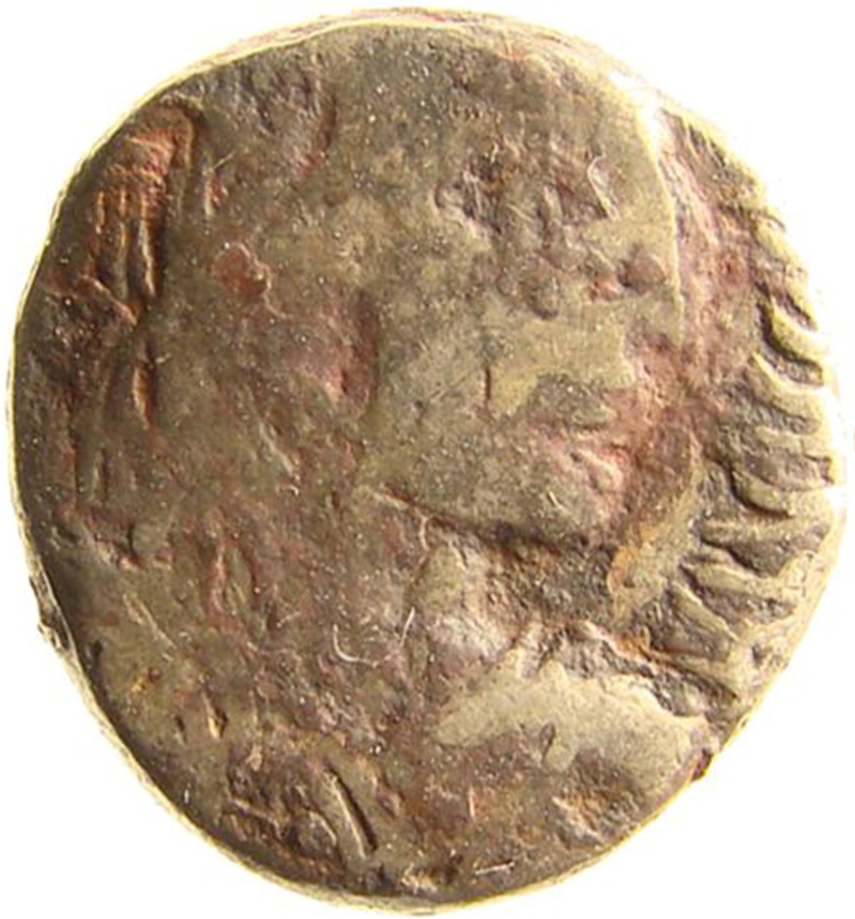

Obv.: Bust of Aretas IV
r. with long wavy hair, combed down from the forehead, with
horizontal stripes at the back; he wears a mantle with a
V-shaped opening decorated with two rows of beads and tassels on
the shoulders; moustache; around from r. below:
»Aretas king of the
Nabataeans who loves his people«. No letter in the field.
Rev.: Jugate head of
Aretas laureate and bust of Shuqilat r., draped; around from r.
below: »Shuqailat queen of the
Nabataeans, year 40« (). The figure ›40‹ is incomplete. No letter
in the field.
Aretas IV drachms dated
year 40 have not previously been reported. The upper parts of
the numerals in the date of the illustrated coin are off flan,
but the space just after the second ›20‹ of the date is clearly
empty. No additional numeral could fit into this space.
3. Aretas IV, Year
41, 32/33 CE, AR Drachm, 14 mm, 3.76 g, 1 h (fig. 3)
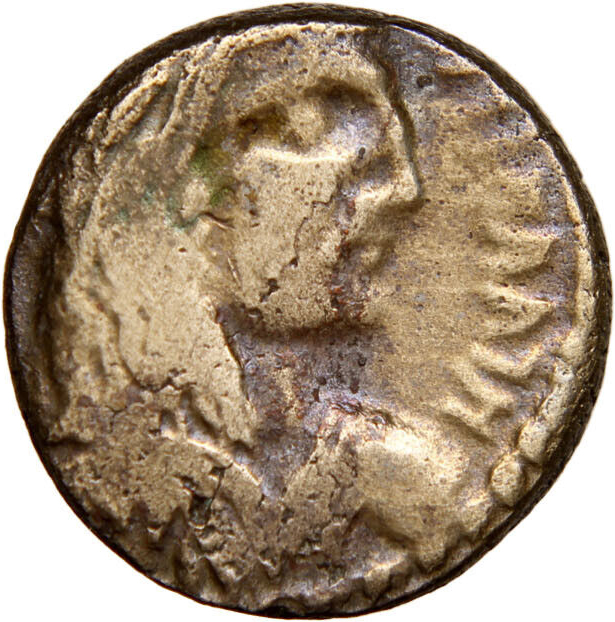
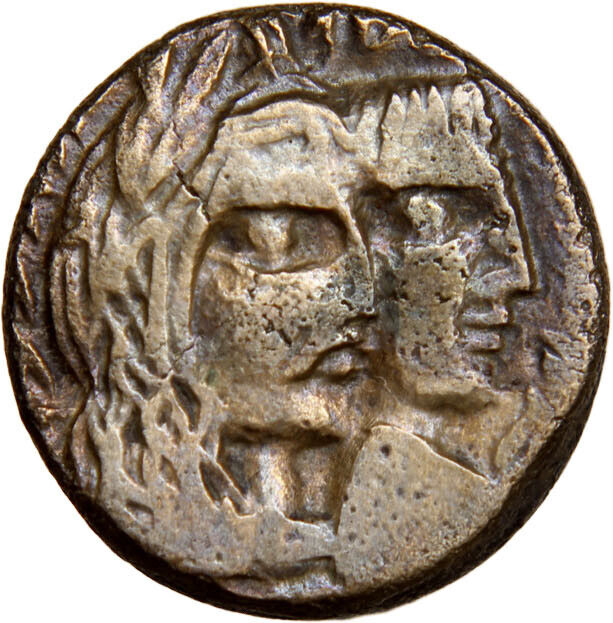
Obv.: Bust of Aretas IV r. with long wavy hair, combed down from the forehead, with horizontal stripes at the back; he wears a mantle with a V-shaped opening decorated with two rows of beads and tassels on the shoulders; moustache; around from r. below: »Aretas king of the Nabataeans who loves his people«
Rev.: Jugate head of
Aretas laureate and bust of Shuqailat r., draped; around from r.
below:). Only traces of the numeral are preserved.
This type, shown in
fig. 3, has been described by Meshorer[8]
based on earlier publications; however, Barkay was not able to
locate the two coins referred to by Meshorer. Barkay therefore
kept this type in her comprehensive work[9]
and marked the coin type as not yet confirmed[10].
The coin shown in fig. 3 is well centered but the die is
too large for the flan to accommodate the complete legend. This
situation is quite typical for late Nabataean drachms; however,
the lower part of the numerals of the date remain clear. Two
›20‹ numerals are readily identifiable, while the last numeral
of the date, positioned right after the second ›20‹ clearly
includes one straight vertical line, suggesting a ›1‹. No
additional parallel lines are visible, so the year cannot be ›2‹
or ›3‹. The line is straight and not curved, so the date cannot
contain a ›5‹. The last alternative would be ›4‹, in which one
of the lines forming an X is off flan. The line on the
illustrated coin is, however, strictly vertical, not typical for
a ›4‹ during this period and not observed on existing drachms of
the year 44 available for review. We suggest that the coin
depicted in fig. 3 is indeed dated year 41. The existence
of this type and year is thus no longer in question.
4. Malichus II, Year
14, 53/54 CE, AR Drachm, 15 mm, 4.36 g, 11 h (fig. 4)
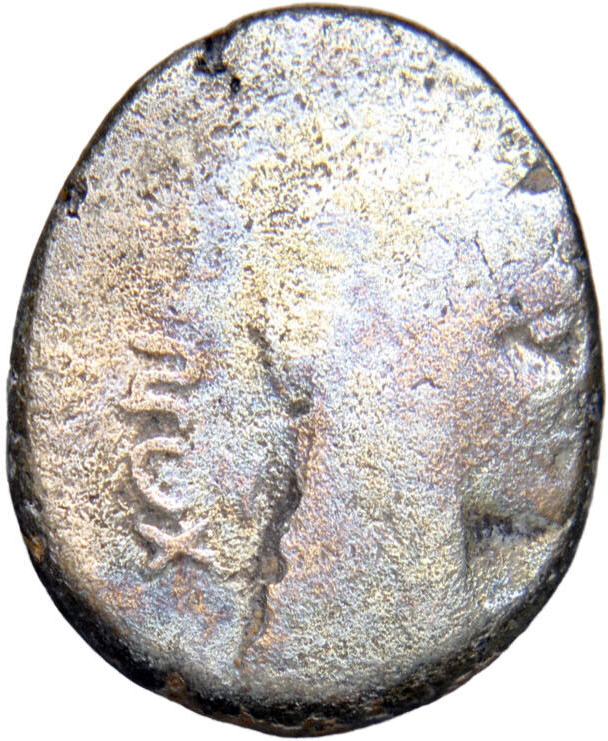

Obv.: Draped and
laureate bust of Malichus II r., with long hair and probably a
moustache; around from r. below:). The figure ›14‹ is quite clear.
Rev.: Draped bust of
Shuqilat II r., veiled; around, from r. below:
The coin has an unusual ovoid shape.
The presence of the word
אחתה
(»sister«) shows that the coin belongs to King Malichus II and
not to Aretas IV whose second wife had the same name. Silver
coins of Malichus II are significantly scarcer than those of his
father Aretas IV[11].
Some of the years and types are known from only one example[12].
The coin shown in fig. 4 is well worn; however, the date
is quite clear. With reporting of this coin, the number of
missing years of Malichus’ rule for which no drachms are known
is lowered to just four: years 2, 3, 4, and 12[13].
It is quite likely that coins of these years will eventually be
discovered. The most likely date to be discovered appears to be
year 12.
5a. Rabbel II, Year
14, 83/84 CE, AR Drachm, 13.5 mm, 3.24 g, 12 h (fig. 5A)
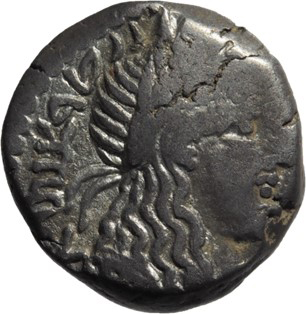
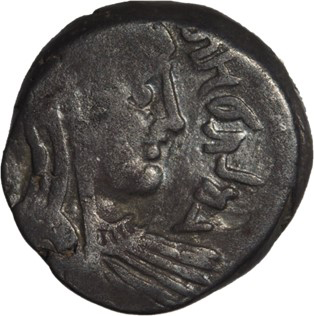
Obv.: Bust of Rabbel II
r., laureate, long hair; around from l.:).
The name of King Rabbel is off the flan.
Rev.: Veiled and draped
bust of Gamilat r.; around, from r.:
5b. Rabbel II, Year
14, 83/84 CE, AR Drachm, 13.5 mm, 3.51 g, 12 h (fig. 5B)
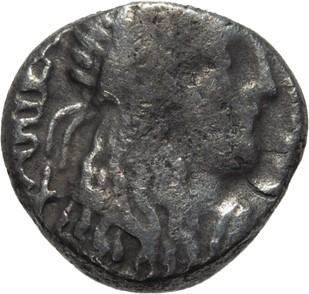
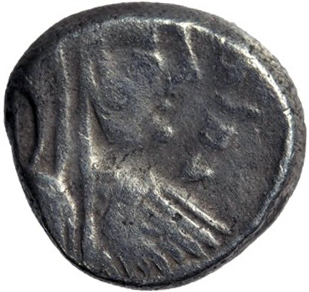
Obv.: Bust of Rabbel II
r., laureate, long hair; around from l.:).
The name of King Rabbel is off the flan.
Rev.: Veiled and draped
bust of Gamilat r.; around, from r.:
6. Rabbel II, Year
15, 84/85 CE, AR Drachm, 3.3 g, 15 mm (fig. 6)
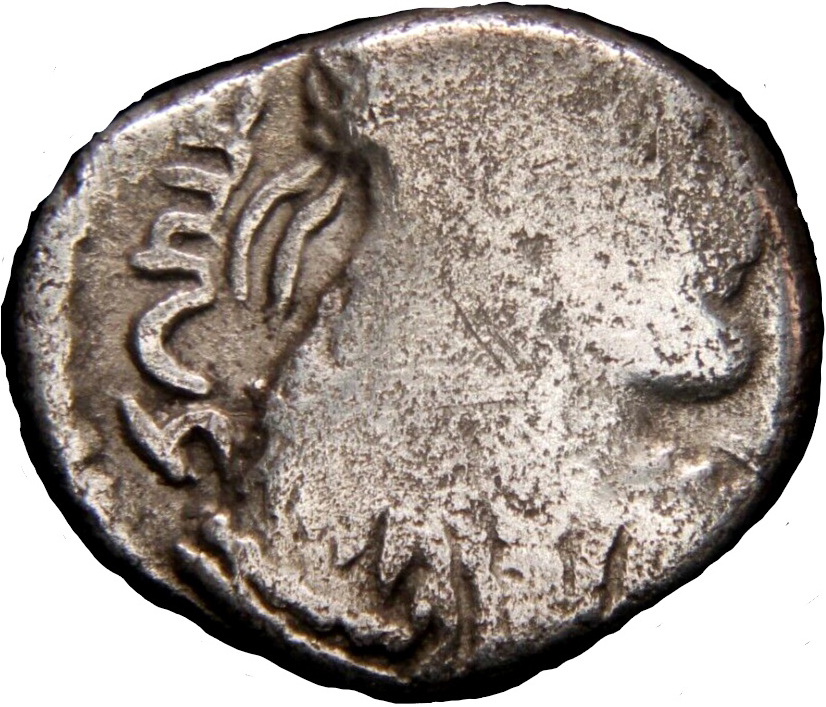

Obv.: Draped bust of
Rabbel II r., laureate, wearing V-shaped mantle. Around from r.:
(»Year 15«)
Rev.: Veiled and draped
bust of Gamilat r.; around, from r.:
7. Rabbel II, Year
18, 87/88 CE, AR Drachm, 2.8 g, 14 mm (fig. 7)
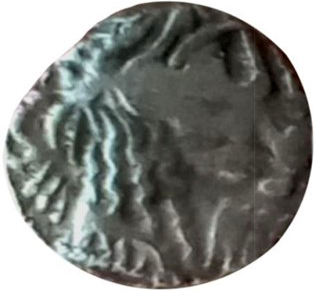
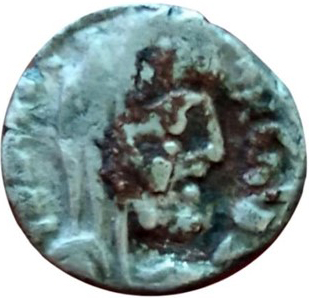
Obv.: Draped bust of
Rabbel II r., laureate, long hair; wearing V-shaped mantle.
Around from r.:). The name Rabbel is vague.
Rev.: Veiled and draped
bust of Gamilat r.; around, from r.:
8. Rabbel II, Year
31, 100/101 CE, AR Drachm, 3.46 g, 13 mm, 1 h (fig. 8)
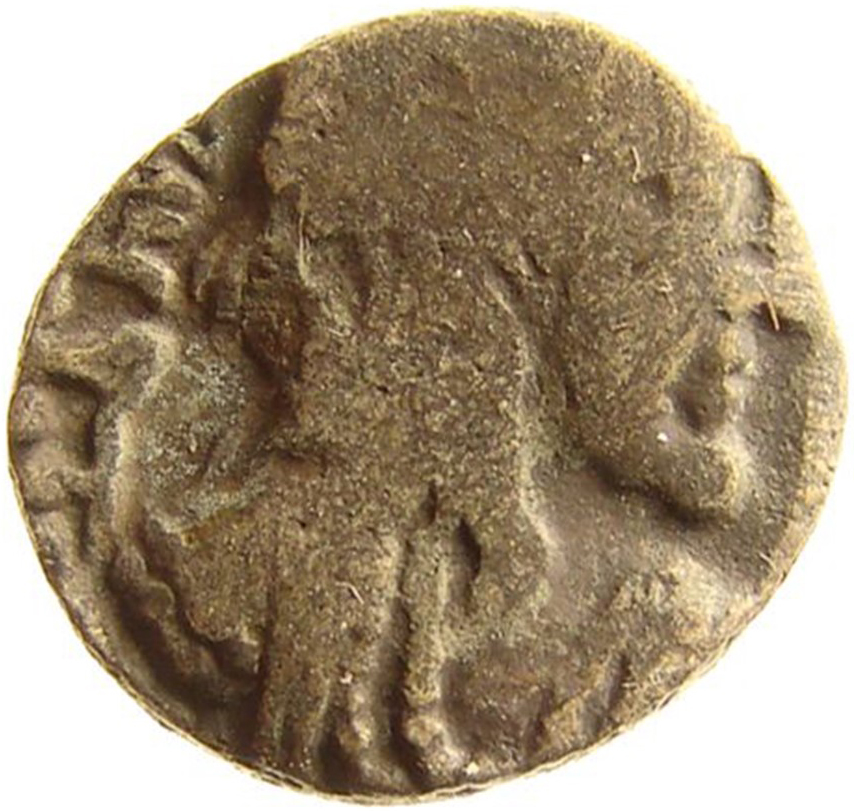

Obv.: Draped bust of
Rabbel II r., laureate, long curly hair down to his shoulders;
crude style; wearing V-shaped mantle
closed in front and ornamented with beads. Around
from l.: »Year 31«
(![]() ). The name of Rabbel is faintly
indicated.
). The name of Rabbel is faintly
indicated.
Rev.: Draped bust of
Queen Gamilat; around, from r. below:
The date of the coins
illustrated in figs. 5, 6 and 7 is clear,
while the date of the coin pictured in fig. 8 is
less certain. However, a comparison with previously published
coins reveals that this drachm was struck with the same obverse
die as Al-Qatanani 242[14],
attributed to year 31. Discovery of a second example confirms
the date proposed by Al-Qatanani. Moreover, yet a third drachm
bearing this date was auctioned several years ago. This
additional drachm was struck with different dies and has an even
more confidently readable date[15].
The coins depicted in
figs. 5, 6, 7 and 8 contribute to our
knowledge of the evolution of minting during the rule of the
last Nabataean king. Until now, drachms minted during only
fourteen out of thirty-five years of Rabbel II’s reign were
known[16].
While it is not very likely that drachms from all thirty-five
years will eventually be discovered, we can now add four more
years/types to our knowledge of the minting during the rule of
the last Nabataean king. Years 14, 15, and 18 can now be added
to the stretch of almost continuous minting from years 11 to 15
and years 17 to 22. The existence of drachms dated years 14 and
15 suggests that the production of Nabataean silver coins likely
continued during year 16 as well. Moreover, a drachm attributed
to year 16 has been published by Al-Qatanani[17];
however, the coin appears to be altered and until a better
preserved example is discovered we cannot reliably fill this
gap.
The existence of a year
31 drachm is historically highly important for several reasons.
Numismatic evidence is one of the few sources of information we
have on the Nabataean kingdom. Until now it has been assumed
that during the last thirteen years of Rabbel II rule silver
coins were not produced, suggesting unfavorable economic and
political conditions. The fact that at least three specimens of
year 31 drachms survived despite massive overstriking of Rabbel
II drachms during Trajan’s rule suggests that the coins were
minted in significant quantity, dismissing these economic and
political assumptions. The production of Nabataean silver coins
after year 22 was not limited to just year 31. The authors also
know of the existence of at least one drachm clearly dated to
year 29 of Rabbel II which is also quite similar in style to the
year 31 coins[18].
The style of all four coins is also remarkably similar to the
bronze issues attributed by Rachel Barkay to the later years of
Rabbel II’s reign[19].
Remarkably, year 31
drachms still bear the portrait of queen Gamilat, suggesting
that Hagaru was the queen for no more than the four last years
of the existence of the Nabataean Kingdom. Alternatively, Rabbel
II could have simultaneously been married to both of his
sisters, Gamilat and Hagaru. We hope that future discovery of
additional dated coins will further clarify these issues.
[1]
Meshorer 1975.
[2]
Barkay 2019.
[3]
Al-Qatanani 2020.
[4]
Barkay 2019, p. 48.
[5]
Barkay 2019, p. 113 types 145–146.
[6]
Barkay 2019, p. 50.
[7]
Hoover 2020, coin 134; Barkay 2020, p. 140 Add. 26.
[8]
Meshorer 1975, p. 104 no. 107.
[9]
Barkay 2019, p. 118 no. 178.
[10]
Barkay 2019, p. 61 note 5.
[11]
Barkay 2014.
[12]
Barkay 2019, p. 63.
[13]
Barkay 2020, p. 143.
[14]
Al-Qatanani 2020.
[15]
https://cngcoins.com/Coin.aspx?CoinID=355923 and
https://cngcoins.com/Coin.aspx?CoinID=242452, the
same group of three coins auctioned twice. The year 31
drachm is pictured in the bottom left corner in the
first link and on top in the second link.
[16]
Barkay 2019, p. 72.
[17]
Al-Qatanani 2020, type 236.
[18]
Younis Al-Qatanani, personal communication.
[19]
Barkay 2019, type 236.
Picture credits: figs. 1, 3, 4, 6: House of Caesars & Caliphs; figs. 2, 8: D. Hendin; figs. 5A, 5B: A. Kaplun; fig. 7: Y. Al-Qatanani